

WDCF Newsletter Summer 2025
In This Edition
Cycling with Wakefield District Cycle Forum
Events:
– Cycling For All
– Liquorice Festival
– Holiday Wednesdays
– Women of Wakefield WoW
Tandem WoW
More on the Women of Wakefield
Bike Doctors
Introduction
Spring came early this year and summer’s about over now. The dry heat meant that for the first time we had a crop of figs in our garden so ripe that they burst, attracting an annoying swarm of wasps. Possibly the same ones who’ve been pestering customers in the café at Nostell NT all summer!
Shaded cycle routes have proved more popular than crossing Sahara-like open tracts of land. Muddy paths have been replaced with bone jarring concrete ruts and some streams have been reduced to trickles. Brambles have joined the blackthorn in drooping over paths and attacking unsuspecting cyclists. Although a helmet keeps them out of your hair, it’s not been the weather for wearing long socks to protect shins and many show scratches and scars.
Apart from our routine rides programme, summer has brought out the usual crop of festivals and events, plus our iconic Holiday Wednesdays. None of this would be possible without our teams of enthusiastic and willing volunteers and thanks are due to all of you.
Cycling With Wakefield District Cycle Forum
Often people join WDCF as a temporary measure, perhaps just to take part in a particular ride, while they regain their confidence following a long interval since they last got on a bike, or because they are unfamiliar with the area or its off-road cycle routes. Experienced riders recovering from an accident or health incident may prefer to ride with a friendly group until they’re fully fit. When they’re ready, these people cycle off into the sunset with our blessing.
Thankfully, some stay with us to become ride leaders or back markers, while others help maintain cycle routes and assist at events like Holiday Wednesdays or to join our autumn path clearing team. Of course, the committee also helps keep the Forum going and promotes it both locally and more widely, whilst endeavouring to improve cycling provision in the district.
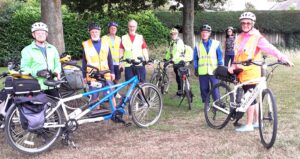
Another section of the membership simply continues to come on rides with us, quietly encouraging nervous riders, explaining group riding protocols and holding gates open, taking advantage of the physical and mental health benefits of cycling and contributing to the camaraderie.
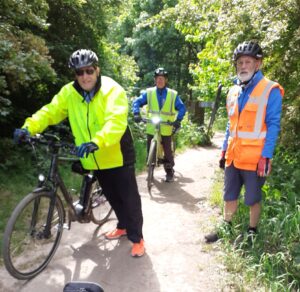
Of course, membership of WDCF does not preclude you from liaising with or joining other groups. Members ride or volunteer with Pontefract Cycle Club, Open Country and the Tandem Club, to name just a few.
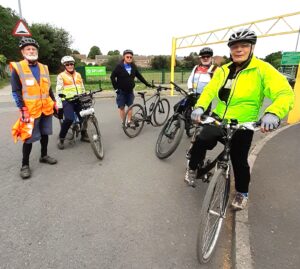
Our Facebook page carries details of our rides each month together with reports and photos from those attending. In alphabetical order, here are photos of our Agbrigg ride in July, a smaller party on the Fitzwilliam ride in May and our the Ryhill ride the same month.
Events
Cycling for all
On the 16th August a small team of WDCF volunteers turned out for an inclusive sports event at Thorne’s Park Leisure Centre and the adjoining sports field. Sharon attracted visitors to our information stand with her renowned tombola stand, while David K, Meg and Sharon talked to anyone in reach. 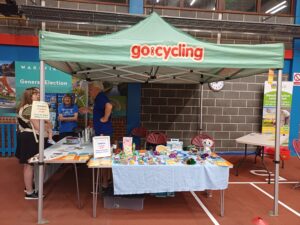
Attractions weren’t limited to games of chance, however. Once again there were dancers, but this time not a stick of liquorice in sight.
Talking to other stall holders was enlightening. Apparently Brazillian Jiu Jitsu / Judo courses can teach people how to fall without hurting themselves. Nordic walking with poles can improve stomach muscles, although cycling is better for the knees. Whilst A-frames, chicanes and overhanging brambles make many of our rides impossible for a side by side bike, I did suggest to a full-time carer that joining us for a free easy guided ride with a borrowed bike and helmet would be an inexpensive way to get some fresh air and exercise. They would meet some new people while their partner could take over caring duties for a morning.
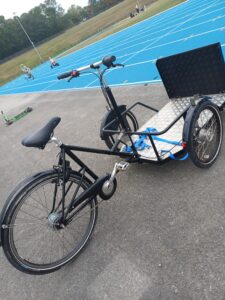
Outside, there were a variety of adapted cycles to try out or simply look at and ask questions about. The photo shows a tandem where the rider in front is a wheelchair user.
Liquorice Festival
Pontefract is well known for its liquorice sweets, particularly Pontefract cakes, a local delicacy first created by chemist George Dunhill in 1760. Pontefract Liquorice Festival is much more recent, dating only from the 1990s. Nevertheless, it attracts visitors from across the county and further afield. The festival features music and dance, parades and performances, talks and stalls manned by local charities and interest groups. The last of these is where WDCF comes in.
A local contingent, consisting of Sandy Clark and David Leigh from Pontefract, Meg and Neville Andrews from Ackworth and Lisa Wilson from Castleford turned up for all or part of the festival on Sunday the 13th July. Armed with our rides leaflets and WoW maps, we chatted to people visiting our stand and anyone in hailing distance of it. 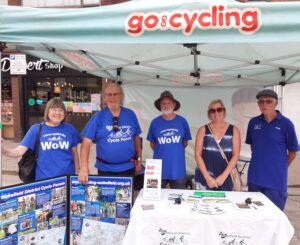
Some of us visited other stands, not to sample liquorice gin but to extol the joys of cycling and to explain the rides programme we put on. Anyone with children was told about Holiday Wednesdays, starting later that month.
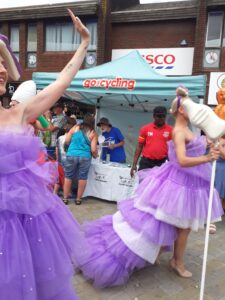
Our stand was in prime position to watch the colourful dancers wearing liquorice allsorts themed costumes and twirling ribbons as they paraded to the Market Place.
Holiday Wednesdays
It’s possible to visit Nostell NT’s spacious grounds, tearooms and toilets free of charge. For National Trust members or paying visitors there is also the mansion itself, the adventure playground and the gardens. For others, WDCF’s Holiday Wednesdays have become an annual tradition.
The route of our circular skills course on the lawn immediately in front of the house varies slightly each week – as does the weather. Children can use their own bikes or borrow one of ours, whether they want a balance bike or something bigger. The same applies to helmets, which we insist children wear. 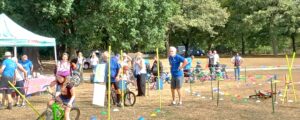 Most children want to have their circuit timed, although they are welcome to an untimed practice run first. We offer signed certificates showing they have completed the course, with the time added if they wish. If numbers aren’t too high, they are welcome to try and beat their initial time and some come back again and again. We also offer guided rides round Nostell for those more confident on their (or our) bikes.
Most children want to have their circuit timed, although they are welcome to an untimed practice run first. We offer signed certificates showing they have completed the course, with the time added if they wish. If numbers aren’t too high, they are welcome to try and beat their initial time and some come back again and again. We also offer guided rides round Nostell for those more confident on their (or our) bikes. 
Sometimes, one or more of our bike doctors will be in attendance to mend or mark bikes and we’ve always got a ride leader or two handy to adjust seats and helmet straps.
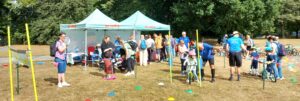 2025 is the last time we will have a fundraising tombola stall at Nostell, ably stocked and run by Sharon, but we will continue to offer information, encouragement, programmes, and maps all without charge.
2025 is the last time we will have a fundraising tombola stall at Nostell, ably stocked and run by Sharon, but we will continue to offer information, encouragement, programmes, and maps all without charge.
Women of Wakefield WoW
Last year, as part of the ‘Our Year’ celebrations, we put on a Big WoW event setting off from Pugneys Country Park -see our Autumn 2024 newsletter for details. WMDC asked us to put on another WoW event this year so Tillie Davies, a Physical Activity Programme Officer with the council, and I put our heads together. The council is in the process of putting up new blue plaques to mark notable women in the district who have largely been overlooked or ignored. After discussion, we agreed to put on a WoW celebrating Women of Wakefield.
We chose the date of the 7th September as we hoped people would be back from their summer holidays by then and our volunteers recovering from the hard work of Holiday Wednesdays. The September ride was due to start from The Hepworth Wakefield, named after our own Women of Wakefield Barbara Hepworth, and this seemed an appropriate place to begin. Tillie and I researched suitable subjects for celebration linked, however tenuously, with places on the route of the WoW. Pages of research were synthesised into more succinct snapshots while Tillie managed to find photos of many of the chosen few. The ride was publicised formally and informally with websites, Facebook, emails and accosting any woman with a bike.

The day dawned a bit chilly on the 7th and Neville and I made our way to the Hepworth. There was a small group of cyclists assembled by the cycle racks when we arrived, all men and all come to join the WoW WoW. For a time, it looked as though I was going to be the only ‘Woman of Wakefield’ there and I was born in down south! Then Tillie arrived with a clutch of female cyclists she’d come across in the Hepworth car park. As 10 o’clock approached, the trickle turned into a flood and we finished up with 26 cyclists on 25 bikes and the majority of the riders were female. It was nice to see Forum members from across district and groups of women who were new to the Forum and had come especially for this ride.
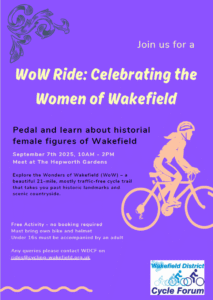
The poster advertising the ride gave the timing as 10am to 3 pm as we weren’t sure how much our talks would extend the ride and we didn’t want anyone picking up a fine for overstaying their parking. In the end, the ride finished at around 2.30pm after one stop to remove jumpers when the sun came out and a second to put on waterproofs when we left the tree covered track and the light showers became more persistent. 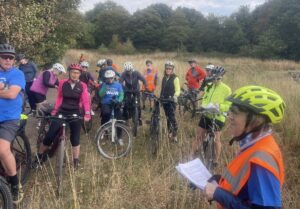
We’re hoping to see many of our new female riders again and dished out multiple copies of our ride programme. One commented that she’s seen the WoW signs and fancied trying the route but hadn’t felt confident enough to do it on her own. That was really the aim of the ride. Another asked if we were going to post our short synopses of the lives of our chosen women on Facebook as she hadn’t heard everything- a problem we faced trying to address a group of cyclists strung out in a line next to the path rather than organised in a clump. 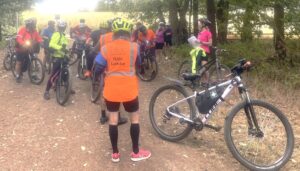 Always short of material, I advised her that our Tessie- talks and Meg’s musings would appear in the next newsletter (this one), due imminently.
Always short of material, I advised her that our Tessie- talks and Meg’s musings would appear in the next newsletter (this one), due imminently.
Tandem WoW
Meg & Nev met a couple of local members of the Tandem Club at the York Cycle Rally in June. They try to organise a ride at least once a month and like us, sometimes struggle to get people on their rides.
We have done the WoW a few times on our tandem and although some of the sections are a little challenging, we offered to lead a Tandem Club ride in August, starting from the Waterside Car Park in Wakefield.
The Hepworth is a great introduction to the WoW but the next section to Chantry Bridge is somewhat of a pain. Then follows a pleasant amble through the woods to Heath via the steep hairpin up to Kirkthorpe Lane.
Crossing Doncaster Road at the lights always takes ages and this time was no exception. These lights should really be more co-ordinated to allow pedestrians, horses and cycles to get across in one go and not piecemeal, as at present.
The rest of the route to Nostell was uneventful and we spent a pleasing half hour sampling scones and tea at the café.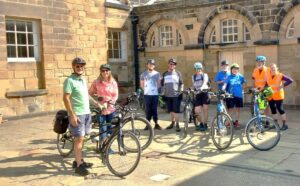
Then through Anglers and past Cold Hiendley reservoir, which always seems to live up to its name, followed by the interesting zig zag up to Navvy Lane, always more fun with a long wheelbase vehicle.
Along the Chevet Branch line and down through the woods at Newmillerdam to reach Pugneys where we had a brief stop to admire Sandal Castle in the distance.
After that it was a short trip back to the car park. On the day, we had four tandems and one single bike and even with the odd sharp bend and uphill zig zag, everyone said they enjoyed the ride.
At the end of the ride, we were given the tired but treasured solo bike on the basis that we would ensure that it was fettled and passed on to a good home, so that’s what we did.
Neville Andrews
More on the Women of Wakefield
Our starting point for the 2025 Women of Wakefield: Wonders of Wakefield ride was The Hepworth, named after the sculptor Dame Jocelyn Barbara Hepworth or more commonly Barbara Hepworth.
Although Barbara Hepworth spent the latter half her of her life in Cornwall, we claim her as a Woman of Wakefield as she was born here in 1903 and went to Wakefield Girls’ High School. Remaining in the West Riding, she won a scholarship to Leeds School of Art from 1920, followed by a county (Yorkshire!) scholarship to attend the Royal College of Art (RCA) in London, and in 1924 travelled to Florence on a West Riding Travel Scholarship. This was in the days before student grants!
While at Leeds, she met fellow Yorkshireman Henry Moore and, although friends, they became professional rivals. Barbara Hepworth was the first to sculpt the pierced figures that are characteristic of both her own work and, later, that of Henry Moore.
Barbara’s first marriage in 1925 was to sculptor John Skeaping, winner of the prestigious Prix-de-Rome, for which she was the runner-up. They had a son together. In 1931 Barbara met and fell in love with the painter Ben Nicholson. They had triplets, Rachel, Sarah and Simon in 1934. Of course, Barbara continued producing her art, commenting: “A woman artist is not deprived by cooking and having children, nor by nursing children with measles (even in triplicate)– one is in fact nourished by this rich life, provided one always does some work each day; even a single half hour, so that the images grow in one’s mind.”
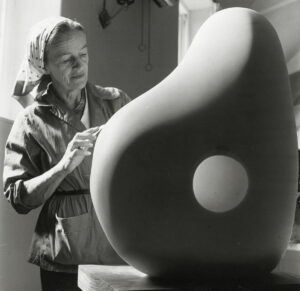
When war broke out, Barbara and her children moved to St Ives in Cornwall, where she remained. Towards the end of her life, when she was not very mobile and drinking heavily, Barbara Hepworth would take a sleeping pill and then light a last cigarette in bed. The pill took 15 minutes to knock her out, the cigarette 10 minutes to smoke. On 20th May 1975, the inevitable happened and she died in a fire at her home in Cornwall, aged 73.
There is a permanent exhibition of Barbara’s work at The Hepworth and Yorkshire Sculpture Park (which you can cycle to and park your bike at but cannot cycle round) is the only place in Europe where you can see all 9 elements of Barbara Hepworth’s iconic artwork ‘The Family of Man’ displayed together. Each figure represents the different stages of life, from youth to old age and together they form a family of sculptures.
The ride’s next stop was at Heath where Baronetess Dame Mary Bolles lived. Mary Witham was born in 1569 into a wealthy family at Ledston Hall Castleford. Her father died when she was 14 and 10 years later a local woman Mary Pannal was accused of having caused his death by witchcraft and tried and executed for the crime. They say she was the last witch to be burnt to death in England.
Mary Witham married well, twice and, having survived both husbands, bought Heath Hall near Wakefield, later known as Old Heath Hall. She was created a baronetess in her own right by Charles I in December 1635 becoming Dame Mary Bolles.

Mary died aged 81 on 5 May 1662 and her will left the interest from £500 for poor children in Wakefield and £200 for poor children in Sandal to be bound apprentices. It directed that the room where she died be permanently sealed. The room was closed off but after fifty years it was opened and from then on, the ghost of the infamous Blue Lady haunted the Old Hall, Heath. The door of the haunted bedroom has been preserved in Wakefield Museum. You can also still see Dame Mary Bolles’s water tower. Built in the 1600s over a hillside spring, it contained an 18 foot (5 metre) water wheel which pumped a water supply to Heath Old Hall on the hill above. The Hall has been demolished but the water tower remains as a grade II listed building.
From Heath we cycled on to Crofton, where Tillie gave a short talk about Richmal Mangnall. Miss Magnall (1769-1820) started as a pupil at Crofton Hall School for Girls in around the 1780s and progressed to become a teacher there from the 1790s until in 1808 when she took over as the school’s headteacher.

So what? you may ask. In 1798, she published the first edition of her Historical and Miscellaneous Questions for the Use of Young People. At first, the book was intended for use at the school in Crofton but later it became an influential textbook used at schools across the country. By 1857, nearly 40 years after its creator’s death, it had reached 84 editions and ‘Mangnall’s Questions,’ as it became known, was referenced by many influential writers and social commentators, including Charles Dickens, Elizabeth Gaskell, and James Joyce.
We then proceeded to Nostell, lunch and Sabine Winn
Sabine Louise Winn was born in Vevey in Switzerland on 25 March 1734. After the death of her first husband in 1761, she met Sir Rowland Winn, the 5th Baronet, when he was on the Grand Tour. They fell in love, married and lived in London for several years before moving to Winn’s family home in Yorkshire in 1765, a place she described as “one of the most desolate and ill-fated corners of the universe”.
The couple commissioned Thomas Chippendale and Robert Adam to redesign the interior of Nostell Priory. They were painted by Hugh Douglas Hamilton in 1767, a picture of serenity, happiness and domestic bliss, but behind the smiles of 18th-century “lady of the house”, Sabine Winn’s is a story of isolation, loneliness and marital anguish.

Despite her efforts, she never mastered English and her husband was rarely there and invariably away on business. “I want to live only for you, yet I am always without you,” she wrote in 1769. Sabine struggled to fit into the role and responsibilities of such a grand country house. “I shall no longer act tactfully if you do not come back this week,” she wrote in one letter. “In the name of God return to your senses and show that you have feelings of your own. The truth is that you love London a good deal more than you do your wife.” Winn would sometimes respond by promising her a new pet!
There were numerous financial and family problems along the way, not least with their two children. Sabine was said to have cosseted her son so much that the Winn family tried to have him removed from her care. Her daughter brought “shame” by marrying a baker.
Nostell Priory today has only one completed wing because Robert Adam’s plans were not fully realized. He designed four new wings, but only the family wing was built, and construction was halted after the death of Sir Rowland Winn, the 5th Baronet, in 1785. This resulted in the asymmetrical façade that is seen today
After moving to Nostell in 1765 Sabine is not thought to have left Yorkshire at any time until her death in 1798. The challenges Sabine faced at Nostell – the language barriers, the strained family relationships, her worries over physical and mental health – are all concerns that resonate today.
From Nostell we proceeded to Anglers Country Park where Tillie told us about Florence Beaumont
Florence Margaret Beaumont was born 17th of June 1876, in Stanley, Wakefield. When asked at the age of 14 what reform was most necessary, she replied ‘that women should vote’. From a young age, she set her sights on securing the right to vote for all women. She did use a bicycle to get around, wearing bloomers on the basis these were most practical. Despite not actively seeking power for herself, her unwavering will and unshakable morality propelled her to prominence, and she founded and helped run several women’s rights and suffrage organisations. Florence was among those chosen to represent the women’s voice at the League of Nations in 1928.
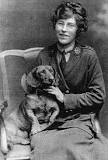
Florence died unexpectedly a year later, cutting short her remarkable life. Her legacy lives on today in every woman when they exercise their political power.
Our final stop was at Pugneys Country Park near the miniature railway station, from which we could see Sandal Castle, once the home of Alice de Lacy
Born on Christmas Day 1281 at Denbigh Castle, Alice de Lacy was a wealthy heiress and the last of the De Lacys. She was married to her first husband, Thomas of Lancaster, when she was just 12. The marriage meant that the De Lacy inheritance, including Pontefract Castle, passed to Thomas, who became the richest and most powerful man in England.
In 1317, Alice was at the centre of a clash of the two castles when John De Warrenne of Sandal kidnapped her in revenge for Thomas humiliating him. Thomas did not try to get Alice back, instead he seized Sandal Castle. Alice and Thomas’s marriage was a long but unhappy one, and ultimately in 1317 Alice left Thomas – a highly unusual action for a medieval noblewoman to take. Five years later Thomas was executed, leaving Alice free to choose her next husband Eubulus le Strange, 1st Baron Strange. Eble died in Scotland in 1335 after about 11 years of marriage and Alice took a vow of chastity.
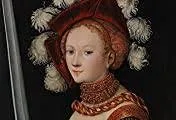
Things then took a turn for the worse for Alice. The very next year she was abducted from Bolingbroke Castle in Lincoln by Sir Hugh Freyne taken to Somerton Castle and married against her will. She petitioned King Edward III for help telling she was being held prisoner, could not see her family or friends and had been forced to break her vow of chastity. Sir Hugh died in Scotland on the King’s service not long afterwards. That wasn’t the end of Alice’s problems with men. In July 1338, Pope Benedict XII ordered the bishop of Lincoln to “warn and compel, by spiritual penalties, Alice de Lacy, countess of Lincoln”, to keep her vow of chastity.
Alice died childless in 1348 aged 66 with no control whatsoever over where her fortune went, its disposition having been settled by her parents, husbands and their families long before that.
Wakefield Metropolitan District has many more notable women and a lot more could have been said about the limited number we chose to feature on our ride. It has been suggested both that we repeat the ride for those who were unable to attend and that a second ride celebrating notable Wakefield men is arranged. I’ll leave it to the men to come up with a list and a suitable name for it!
Bike Doctors
Our two bike doctors, Neville and Malcolm, have been busy this summer.
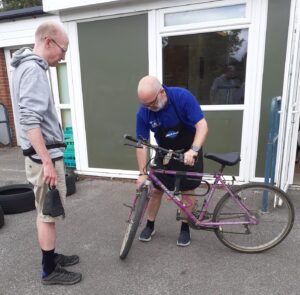
The pictures show them at an event at Outwood Newstead Green School Havercroft, mending and security marking bikes. They have also been present at some of our Holiday Wednesdays adjusting a family’s bike to suit a new rider or security marking a new bike.
Aided by Andy, they’ve also kept the Forum’s loan bikes in good fettle.
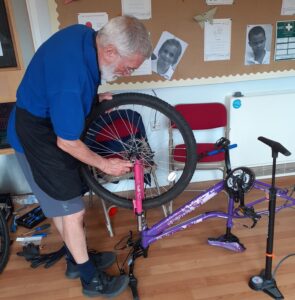
From time to time, we are offered unmaintained and unrideable bikes to add to our stock. Sometimes our doctors are able to resuscitate the patient and return a serviceable bike fit for family use. On other occasions, life support is uneconomic and such bikes are given to charities who combine training cycle mechanics with supplying bikes at little or no cost to those who could do with a bike to get to work but can’t afford one. Experience suggests that asking a friend’s brother or a brother’s friend to look at a second hand bike is asking for trouble!